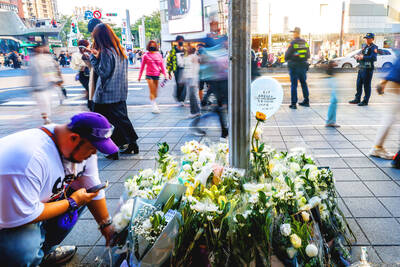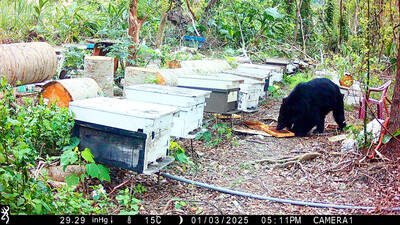The number of Chinese tourists visiting Taiwan rose by 0.59 percent to 249,999 last month, marking the first monthly increase since President Tsai Ing-wen (蔡英文) took office in May last year.
Statistics from the Tourism Bureau showed that the number of Chinese tourists had dropped from a total of 4.18 million in 2015 to 2.66 million last year.
The decline in Chinese tourists had shown double-digit percentage differences since May last year, dropping 12.21 percent in May, 32.41 percent in August, 44.30 percent in October and 32.64 percent in December compared with the same months in 2015.
The only decrease between January and April last year occurred in February, when the number of Chinese tourists dropped by 0.23 percent, the statistics showed.
Data from the bureau showed that the decline continued between January and July this year, with decreases of 30.22 percent in January, 50.09 percent in February, 44.60 percent in March, 42.97 percent in April, 38.31 percent in May, 30.25 percent in June and 20.86 percent in July.
Commenting on the first positive, albeit minor, increase, the bureau attributed the growth to the arrival of independent Chinese tourists as well as those arriving via tour groups (3.39 percent and 6.49 percent respectively).
Apart from summer vacation, events like the Taipei Summer Universiade have also encouraged some Chinese to visit, the bureau said.
The bureau is optimistic about the gradual rebound in Chinese visitors, as positive growth was also reported in the first week of this month, it added.
A freeway bus fire in July last year, which killed all 26 people on board, would have dissuaded many Chinese from visiting Taiwan, which would have in turn affected the number of visitors entering the nation in the months that followed, Quality Travel Development Association chairman Ringo Lee (李奇嶽) said.
Consequently, it is meaningless to compare the number of Chinese travelers last month with those in August last year, Lee said, adding that the industry expects a continuing decline in Chinese tourists.
Meanwhile, the number of Japanese and South Korean tourists dropped by 8 percent and 3 percent respectively last month, the data showed.
The decrease was due to a lack of flights, as many Taiwanese like to travel to Japan or South Korea during the summer, the bureau said.
The bureau said it has formed a 200-strong delegation with the Taiwan Visitors Association and other organizations to attend the Tourism Expo Japan in Tokyo, which opens today, adding that its goal of having 2 million Japanese tourists to visit Taiwan this year remains unchanged.
Significant growth in tourists also occurred for some of the natonis targeted in the government’s New Southbound policy last month.
The number of Vietnamese tourists rose by 85 percent to 31,684, and Philippine travelers increased by 50 percent to 19,711.
Double-digit growth was also seen in the number of tourists from Malaysia (27.52 percent), Singapore (17.41 percent) and Thailand (13.84 percent).
Overall, the nation welcomed 909,381 international travelers last month, rising 5.3 percent from a year earlier.

SHIPS, TRAINS AND AUTOMOBILES: The ministry has announced changes to varied transportation industries taking effect soon, with a number of effects for passengers Beginning next month, the post office is canceling signature upon delivery and written inquiry services for international registered small packets in accordance with the new policy of the Universal Postal Union, the Ministry of Transportation and Communications said yesterday. The new policy does not apply to packets that are to be delivered to China, the ministry said. Senders of international registered small packets would receive a NT$10 rebate on postage if the packets are sent from Jan. 1 to March 31, it added. The ministry said that three other policies are also scheduled to take effect next month. International cruise ship operators

HORROR STORIES: One victim recounted not realizing they had been stabbed and seeing people bleeding, while another recalled breaking down in tears after fleeing A man on Friday died after he tried to fight the knife-wielding suspect who went on a stabbing spree near two of Taipei’s busiest metro stations, Taipei Mayor Chiang Wan-an (蔣萬安) said. The 57-year-old man, identified by his family name, Yu (余), encountered the suspect at Exit M7 of Taipei Main Station and immediately tried to stop him, but was fatally wounded and later died, Chiang said, calling the incident “heartbreaking.” Yu’s family would receive at least NT$5 million (US$158,584) in compensation through the Taipei Rapid Transit Corp’s (TRTC) insurance coverage, he said after convening an emergency security response meeting yesterday morning. National

PLANNED: The suspect visited the crime scene before the killings, seeking information on how to access the roof, and had extensively researched a 2014 stabbing incident The suspect in a stabbing attack that killed three people and injured 11 in Taipei on Friday had planned the assault and set fires at other locations earlier in the day, law enforcement officials said yesterday. National Police Agency (NPA) Director-General Chang Jung-hsin (張榮興) said the suspect, a 27-year-old man named Chang Wen (張文), began the attacks at 3:40pm, first setting off smoke bombs on a road, damaging cars and motorbikes. Earlier, Chang Wen set fire to a rental room where he was staying on Gongyuan Road in Zhongzheng District (中正), Chang Jung-hsin said. The suspect later threw smoke grenades near two exits

The Forestry and Nature Conservation Agency yesterday launched a gift box to market honey “certified by a Formosan black bear” in appreciation of a beekeeper’s amicable interaction with a honey-thieving bear. Beekeeper Chih Ming-chen (池明鎮) in January inspected his bee farm in Hualien County’s Jhuosi Township (卓溪) and found that more than 20 beehives had been destroyed and many hives were eaten, with bear droppings and paw prints near the destroyed hives, the agency said. Chih returned to the farm to move the remaining beehives away that evening when he encountered a Formosan black bear only 20m away, the agency said. The bear